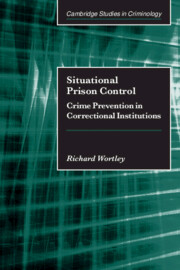Book contents
- Frontmatter
- Contents
- List of figures and tables
- Foreword
- Acknowledgements
- Part I Theoretical foundations
- Part II Specific behaviours
- 5 Prisoner-prisoner violence
- 6 Sexual assaults
- 7 Prisoner-staff violence
- 8 Self-harm
- 9 Drug use
- 10 Escapes
- 11 Collective disorder
- 12 Conclusions: hard and soft situational prison control
- List of references
- Index
11 - Collective disorder
Published online by Cambridge University Press: 22 September 2009
- Frontmatter
- Contents
- List of figures and tables
- Foreword
- Acknowledgements
- Part I Theoretical foundations
- Part II Specific behaviours
- 5 Prisoner-prisoner violence
- 6 Sexual assaults
- 7 Prisoner-staff violence
- 8 Self-harm
- 9 Drug use
- 10 Escapes
- 11 Collective disorder
- 12 Conclusions: hard and soft situational prison control
- List of references
- Index
Summary
Potentially the most serious form of prison disorder is a riot. The two most notorious riots in American history – Attica in 1971 and New Mexico in 1980 – are evidence of the brutality and destructiveness that can be unleashed when prison control disintegrates. These two riots alone cost seventy-six lives and caused tens of millions of dollars worth of damage. As with other forms of prison disorder there are many who readily attribute the causes of riots to the inherently violent nature of prisoners. Explaining the cause of the Attica riot, the warden observed; ‘You are dealing with a highly selected individual who has been a failure from all society’ (Mahan, 1994: 257). However, as the official inquiry into the Attica riot (the McKay Commission) concluded, the causes of the riot can be traced to the physical and social conditions that existed in the prison (New York State Special Commission on Attica, 1972: 31–102). At the same time, Attica was far from unique. Every prison, McKay warned, is a potential Attica (p. xii).
Nature of the problem
Definition and incidence
Like escapes, the incidence of collective disorder is dependent upon the definition employed. According to Wees (1996: 17) ‘an inmate is engaged in a riot when he, with two or more persons, participates in conduct that creates danger or damage or injury to property or persons and obstructs the performance of facility functions’.
- Type
- Chapter
- Information
- Situational Prison ControlCrime Prevention in Correctional Institutions, pp. 190 - 210Publisher: Cambridge University PressPrint publication year: 2002



